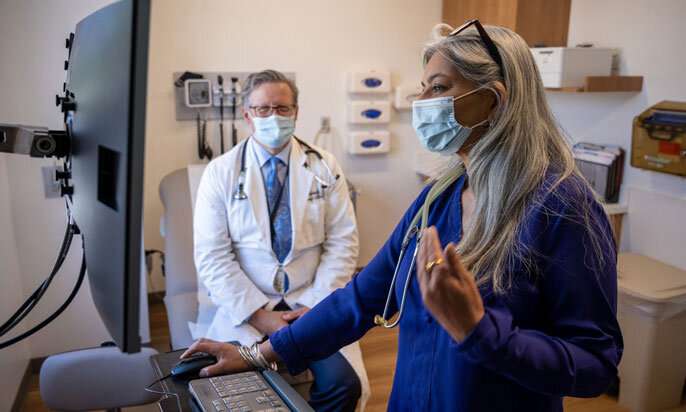Home » Health News »
The frightening uncertainty of long-haul COVID-19

In February, when the world barely knew the name COVID-19, Marina Oshana had what she thought was the flu or some other bug.
“I’m an avid Jazzerciser. I love to dance. I was working out five or six days a week,” the UC Davis professor emerita of philosophy said on the Dec. 3 edition of UC Davis LIVE. “I noticed during the cardio portion of the class, I would get fatigued. It was very strange. It seemed to come on suddenly.”
Her “bug” was SARS-CoV-2, the novel coronavirus, and her COVID-19 case was fairly middle-of-the-pack in terms of intensity. She had a “wicked sore throat” for a day, some exhaustion and about two weeks of a bad cough.
Then she was no longer a “midpack” COVID-19 patient. Some symptoms never went away. Some new ones emerged. Nine months later, Oshana is still fighting fatigue and breathing issues, and her oxygen levels wobble up and down, frequently dropping into dangerous territory. Oshana has become what is being called a COVID-19 “long-hauler.”
“When I’m out walking, I definitely cannot keep up the pace,” she said. “I can get out of breath almost immediately sometimes.”
Christian Sandrock, a UC Davis Health professor of pulmonary and critical care medicine, said Oshana is both typical and atypical of long-haulers—because their symptoms and the severities of the symptoms are enormously varied. And there is no playbook for who might become a long-hauler and how badly they might suffer.
“We’ve had some patients who were profoundly ill in our intensive care unit, then they recovered and had no other symptoms,” Sandrock said. “And some patients will do fine at first and are never admitted to the hospital. Then they have these effects that last and last.”
There are other frightening aspects, he said, including:
- Wide-ranging symptoms—They include respiratory issues and fatigue, like what Oshana is experiencing. Other long-haulers may have a lasting cough, body aches, a continued loss of smell and taste, or—maybe the most confounding—what has been described as brain fog. That’s when thinking clearly becomes hard. “Some patients may have one of these symptoms and some will have a combination,” Sandrock said. “We just don’t know why yet.”
- No precise statistics—Some studies estimate about 10 percent of COVID-19 patients have symptoms that won’t go away, but Sandrock said he’s also seen literature reporting upwards of 20 percent.
- How long is long?—”Unfortunately,” Sandrock said, “we don’t know that, either.” For some people, it’s a few months. For others, like Oshana, they are still experiencing symptoms after nine months.
https://youtube.com/watch?v=G77zQQ41_ZQ%3Fcolor%3Dwhite
Post-COVID-19 Clinic
In response to the growing number of long-haul patients, UC Davis Health recently launched the region’s first Post-COVID-19 Clinic to provide streamlined, comprehensive care from a range of expert specialists. Sandrock is among the physicians providing care for clinic patients.
“We’re realizing it’s a very multidisciplinary event,” he said. “Patients need multiple specialists and they need a specialty clinic where everything they’re dealing with can be evaluated and treated. It can be a scary thing and people need a place to go.”
UC Davis Health is one of only a handful of health systems in the United States to create a clinic that cares for long-haul patients. UC Davis Health research is also connected with the clinic, with the goal of finding answers about the causes and the care needs of long-haul COVID-19 patients.
Useful lessons
Sandrock and Oshana said there are lessons for everyone from Oshana’s case, regardless of whether they have been a COVID-19 patient. It starts with taking health precautions seriously. For post-COVID-19 patients, don’t shrug off signs that your symptoms aren’t going away.
“As you go about your daily life, like walking or riding your bike, if you notice there is something wrong or you’re not back to normal, go see your doctor,” Sandrock said. “We may be struggling with long-haulers in some ways, but there is still a lot we can do to help.”
Oshana said she has found that walking and exercising is still crucial for her—but at a reduced level. For her right now, going too hard can be as bad as doing nothing,
“For people like me, we have to learn to dial back our expectations,” Oshana said. “It’s frustrating and humbling, so maybe take it as a lesson in humility. Do what you can. Listen to your body and not your ego.”
The most important lesson, Oshana said, is that COVID-19 is dangerous for everyone.
“There are people saying you just get over it,” she said. “But you might not get over it. I was not on a ventilator. I was not in the hospital. I was up and around and walking. It seemed like I would be fine, until the new symptoms cropped up.”
Source: Read Full Article



